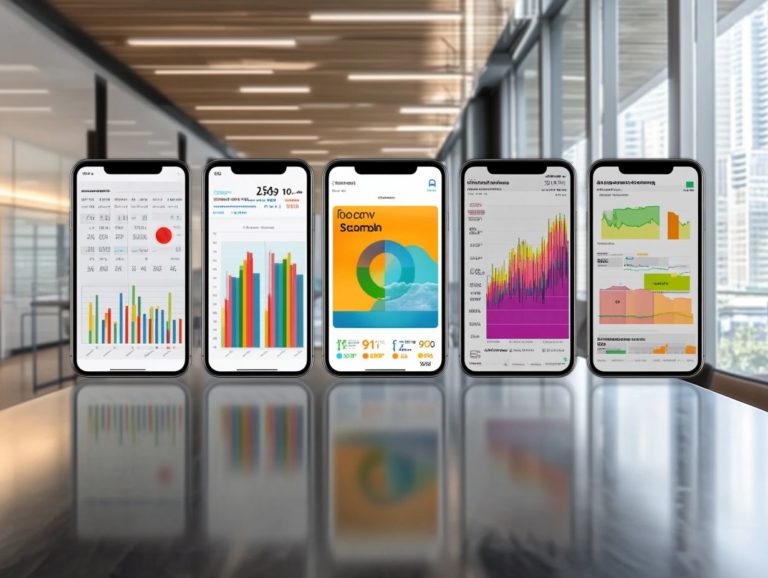Best Performance Management Tool Features for Startups
In today s fast-paced business landscape, you encounter distinctive challenges in managing performance and nurturing talent as a startup.
Navigating these hurdles necessitates the right tools that streamline processes and elevate employee engagement.
This article delves into the essential features of performance management tools designed specifically for startups. From goal setting and continuous feedback to employee development and real-time analytics, discover how these tools can cultivate a thriving workplace culture and propel sustainable growth.
Contents
- Key Takeaways:
- 1. Goal Setting and Tracking
- 2. Performance Reviews and Feedback
- 3. Employee Development and Training
- 4. Collaboration and Communication
- 5. Data and Analytics
- 6. Customizable Templates and Workflows
- 7. Integration with Other Tools
- 8. Mobile Accessibility
- 9. Employee Recognition and Rewards
- 10. Succession Planning
- 11. Real-Time Updates and Notifications
- 12. Employee Self-Service
- 13. Performance Metrics and KPIs
- 14. Continuous Performance Management
- 15. Scalability for Growth
- Frequently Asked Questions
- What are the best performance management tool features for startups?
- Why is goal setting and tracking important for startups?
- How does feedback and recognition contribute to a startup’s performance?
- What role do performance reviews play in a startup’s success?
- How can employee development plans benefit startups?
- Why is data analytics important for startups’ performance management?
Key Takeaways:

- Set clear goals and track progress to ensure focused and effective performance management in startups.
- Regular performance reviews and feedback enhance employee engagement and motivation, crucial for startup success.
- Invest in employee development and training to foster a culture of learning and growth, essential for a startup’s long-term success.
1. Goal Setting and Tracking
In the ever-evolving landscape of startups, effective goal setting and tracking are essential for managing performance. This ensures that both individual and organizational objectives align seamlessly, fostering a culture rich in growth and innovation.
Establish clear performance metrics that guide team goals, facilitate personal development, and enhance overall employee performance.
For startups aiming for rapid growth, goal alignment is crucial. It creates a shared vision and motivates team members to work toward common objectives.
By implementing robust performance management systems, you can track progress against these goals with precision.
Consider utilizing frameworks like OKRs (Objectives and Key Results). OKRs are a goal-setting framework that helps teams measure progress and provide a tangible way to measure performance.
Incorporating best practices like regular check-ins and performance reviews can further enhance this process, allowing for continuous feedback that drives improvement and accountability.
By fostering an environment where constructive feedback is welcomed, you cultivate adaptability and innovation, enabling your teams to pivot quickly in response to market demands.
2. Performance Reviews and Feedback
Performance reviews and continuous feedback are vital elements of a high-performing performance management system, designed to elevate employee engagement and ensure that you feel valued and understood in your role.
These mechanisms do more than just evaluate past performance; they open doors for your growth and development.
Various types of performance reviews, such as 360-degree feedback and self-assessments, cater to your unique needs and preferences, creating a well-rounded evaluation process.
The importance of a strong feedback process cannot be emphasized enough it promotes open communication and strengthens your relationship with managers.
Establishing an effective feedback system means setting clear objectives, encouraging constructive dialogue, and embracing real-time feedback.
All of these can significantly enhance your performance and uplift morale. By making feedback an ongoing process, you can help cultivate a culture of continuous improvement and engagement, leading to greater productivity and job satisfaction.
3. Employee Development and Training
Investing in employee development through targeted training programs is essential for you to close skill gaps and promote career progression within your startup.
It allows you to align talent management strategies with your organizational objectives.
By offering a diverse range of training options think mentorship schemes, workshops, online courses, and webinars you can tailor these initiatives to meet the unique needs of your workforce.
These programs are crucial for pinpointing specific areas where employees might lack proficiency, providing structured learning paths to enhance their skills.
Emphasizing continuous learning cultivates a culture of growth, encouraging your team to engage more deeply with their roles.
This commitment boosts individual performance and contributes to greater job satisfaction, resulting in a more motivated and enabled workforce that drives overall business success.
4. Collaboration and Communication
Collaboration and effective communication channels form the backbone of a strong team culture, allowing you and your team to align your goals. This fosters an open feedback process that sparks innovation and adaptability.
By leveraging strategies like regular team meetings, collaborative project management tools, and digital communication platforms, you can cultivate an environment where ideas flow freely and every employee feels enabled to contribute.
These practices are not just about sharing information; they are essential for building trust and nurturing relationships among team members, which enhances engagement across the board.
When you and your team engage in open communication, you become better equipped to tackle challenges together, adapt to changing conditions, and ultimately drive performance. This interconnectedness acts as a catalyst for organizational success, leading to increased productivity and a culture of continuous improvement.
5. Data and Analytics

Utilizing data and analytics is essential for making decisions based on data in performance management. This enables you to track performance metrics effectively and gain actionable insights that propel your organization toward success.
This approach helps you monitor productivity levels and understand employee engagement patterns. You can identify areas that need improvement. For example, if performance insights show that certain teams consistently outperform others, it may indicate effective leadership styles or successful employee motivation strategies at play.
HR solutions like BambooHR and Workday offer analytics capabilities that allow you to visualize these patterns. With this information, you can allocate resources more efficiently and tailor training programs to fill skill gaps.
Embrace data-driven methods now to create a culture of continuous improvement, boost employee morale, and enhance your overall talent management strategies.
6. Customizable Templates and Workflows
Customizable templates and workflows within performance management software enable you to tailor your processes. This enhances employee engagement and facilitates continuous performance improvement through structured methodologies.
These adaptable tools allow your organization to create specific assessments and feedback mechanisms that truly resonate with your unique company culture and objectives. By leveraging these customizable features, you can align your performance management strategies with your evolving needs. For more insights, consider the key considerations for performance management tool adoption, ensuring that each employee’s growth is nurtured in a way that feels personal and relevant.
The ability to modify workflows allows you to remain agile, responding swiftly to challenges and opportunities as they arise an essential capability in today s fast-paced environment. This flexibility promotes efficiency. It also gives your team a sense of ownership, driving collective success.
7. Integration with Other Tools
Integrating performance management software with other HR solutions is essential for crafting a cohesive ecosystem that enhances employee performance and optimizes feedback systems throughout your organization.
By blending various tools, such as applicant tracking systems (software that helps manage job applications) and learning management platforms, you can streamline processes that typically consume significant time and effort. This seamless integration fosters efficient communication among your teams and provides a comprehensive overview of employee performance and developmental needs.
Take, for example, a tech company that links its performance management software with employee learning modules; they can effortlessly track skills growth and offer targeted training, ultimately boosting engagement and productivity. Such integrations showcase their value by aligning business objectives with performance metrics, creating a more agile and responsive organizational environment.
8. Mobile Accessibility
Mobile accessibility in performance management software lets you use performance tracking tools anytime and anywhere. This flexibility helps create a culture of ongoing feedback and engagement.
In today’s fast-paced work environment, staying connected is essential. Teams can remain motivated, no matter their location.
Key features like user-friendly dashboards, instant notifications, and easy connections with productivity tools enhance your experience. For more information on these aspects, check out how to choose the right performance management tool. With insights available on-the-go, you can track your goals, receive feedback, and engage in meaningful discussions with your managers.
9. Employee Recognition and Rewards
A strong employee recognition and rewards system is crucial for motivating and engaging your team. This system enhances performance management efforts and helps retain top talent.
It fosters a positive workplace culture where employees feel valued. By implementing recognition strategies like peer acknowledgment, performance bonuses, and celebrating milestones, organizations can build a more engaged workforce.
Such approaches not only boost morale but also promote loyalty. When employees see their efforts appreciated, productivity tends to rise, driving better results for the organization.
10. Succession Planning

Succession planning is key for effective talent management. It ensures a pipeline of skilled employees ready for future challenges.
Identifying and nurturing potential leaders early fosters a culture of resilience. This proactive approach minimizes disruptions during transitions and maintains operational stability.
A robust succession plan creates an environment where employees feel valued, boosting retention rates. To create one, consider these best practices:
- Conduct regular talent assessments.
- Provide mentorship opportunities.
- Encourage continuous learning.
By implementing these strategies, you’ll secure your organization s future and enhance its overall success.
11. Real-Time Updates and Notifications
Real-time updates and notifications in performance management software keep you informed and engaged. This fosters a proactive approach to improving performance and aligning with your organization’s goals.
Timely communications enhance transparency and help your team respond quickly to changes. For example, a notification system can alert you about upcoming deadlines or feedback from managers.
By keeping you updated, these systems reduce uncertainty and promote a culture of continuous improvement. Platforms that integrate chat functionalities or direct message alerts enhance collaboration, ensuring important updates are never missed.
12. Employee Self-Service
Employee self-service functionalities in performance management systems enable you to take charge of your performance tracking and feedback processes, significantly boosting your engagement and accountability.
By allowing you to set personal goals, monitor your progress, and request feedback at your convenience, these tools foster a culture of autonomy and ownership.
This transformation enhances your overall experience. It also streamlines communication between you and management.
With clear expectations and access to real-time performance data, you feel more connected to your role and the organization s objectives. This heightened engagement leads to a more cohesive performance management system, where your contributions are recognized, and improvements can be consistently pursued, benefiting both you and the overall organizational climate.
13. Performance Metrics and KPIs
Establishing clear performance metrics and KPIs is essential for you when measuring employee performance and guiding data-driven decision-making within performance management frameworks.
These metrics act as your benchmark for assessing both individual and team contributions, allowing you to identify strengths and uncover opportunities for improvement.
By regularly monitoring these indicators, you can track your progress toward goals, ensuring alignment with the broader organizational objectives.
Effectively utilizing these tools will aid you in fostering employee development by pinpointing skills gaps and training needs. This approach enables you to make strategic decisions that ultimately benefit the organization as a whole.
14. Continuous Performance Management
Embracing a continuous performance management approach allows you to transition from the traditional annual review model to a more agile framework that prioritizes ongoing feedback, employee development, and performance enhancement.
This strategic shift not only cultivates a culture of engagement but also boosts adaptability within teams, enabling them to respond effectively to the ever-evolving business landscape.
When you provide employees with regular insights into their performance and progress, they feel more connected and empowered, paving the way for deeper professional growth.
To truly harness the benefits of this system, organizations can structure their feedback mechanisms to be more frequent and varied.
Incorporating peer feedback, self-assessments, and manager insights creates an inclusive framework where everyone s perspective is valued.
This approach fosters a well-rounded understanding of performance while promoting continuous dialogue that drives improvement and excellence.
15. Scalability for Growth

Scalability in performance management software is vital for startups like yours that are striving for growth and innovation. This flexibility allows you to adapt to your evolving organizational needs while ensuring effective talent management, making it important to explore the top performance management tools for enterprises.
As your company expands, the ability to seamlessly integrate additional users and features becomes paramount. This adaptability not only streamlines the onboarding process for new hires but also supports the implementation of advanced analytics tools that measure employee performance in real-time.
Picture a scalable performance management solution that provides customizable dashboards tailored to different team requirements. This enables you to track progress and effectively pinpoint skill gaps while following the best practices for performance management tool implementation.
These features allow you to make data-driven decisions, foster employee engagement, and enhance overall productivity, ultimately contributing to long-term organizational success, especially with the help of performance management tools for remote teams, even amid rapid growth.
Don’t miss out on the chance to adapt quickly as you grow!
Frequently Asked Questions
What are the best performance management tool features for startups?
The best performance management tool features for startups include goal setting and tracking, feedback and recognition, performance reviews, employee development plans, data analytics, and key features to look for in performance management tools that integrate with other HR systems.
Why is goal setting and tracking important for startups?
Goal setting and tracking helps startups align employees’ individual goals with the company’s overall objectives. This alignment allows for better focus and prioritization of tasks.
It provides a clear roadmap for employees to follow and measure their progress.
How does feedback and recognition contribute to a startup’s performance?
Feedback and recognition are vital for startups. They foster a culture of continuous improvement and motivate employees to strive for excellence.
These elements also help identify areas for improvement and reinforce positive behavior.
What role do performance reviews play in a startup’s success?
Performance reviews offer startups a formal and structured way to assess employee performance. They identify areas of strength and weakness while providing essential features of performance management software for improvement.
These reviews also serve as a benchmark to measure an employee’s progress over time.
How can employee development plans benefit startups?
Employee development plans empower startups to invest boldly in their workforce. They provide opportunities for growth and learning.
This investment improves employee satisfaction and retention, enhances skills, and contributes to the company’s long-term success.
Why is data analytics important for startups’ performance management?
Data analytics provide valuable insights into employee performance. This enables startups to make data-driven decisions and explore the benefits of using performance management tools to identify areas for improvement.
It helps track progress and measure the impact of performance management efforts.



